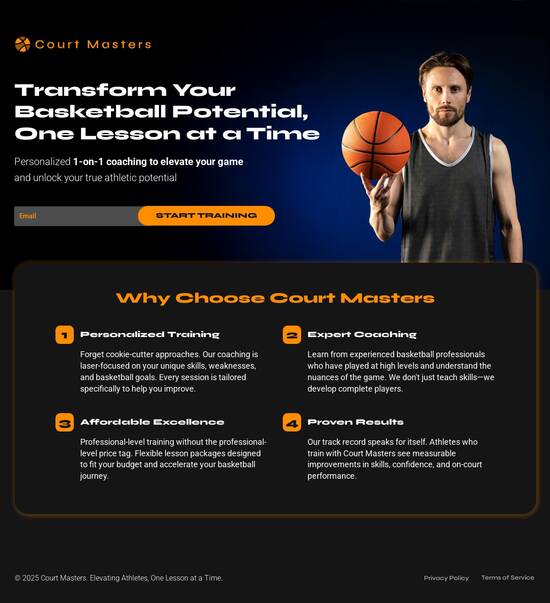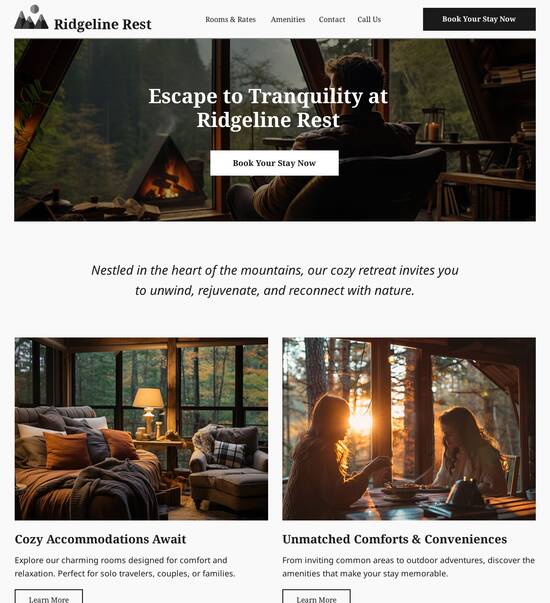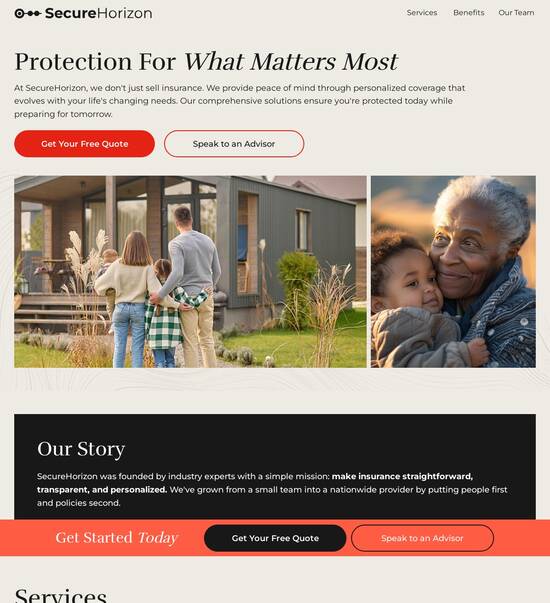
Web page template with interactive modal pop-up
Explore Similar TemplatesAbout template
Use web page templates with interactive modal pop-up and make your communications easy and transparent. Try our solution today.
Recommended templates

Easy to build without coding
With the intuitive drag-and-drop builder, anyone on your team can create high-converting pages without any knowledge of code or design. Make enhancements to your landing page with custom widgets using Javascript, HTML/CSS, or third-party scripts.

Multiple layouts for any industry and goal
Select from 500+ landing page layouts built to boost conversions across industry-specific scenarios. Customize them by adjusting fonts, adding images, and generating on-brand content with the AI assistant. Quickly scale with Instablocks® and Global Blocks that you can save, reuse, and update globally.

Loads fast and looks polished on any device
Every template is responsive, which means they present professionally on any device and load blazingly fast with our Thor Render Engine. You can also power them up with Google AMP technology to deliver an unparalleled mobile experience and drive higher conversions.

Robust analytics & experimentation
Get real-time updates and reporting across all your devices, showing the number of visitors, conversions, cost-per-visitor, and cost-per-lead. Launch AI-powered experiments, run A/B tests, and use heatmaps to analyze user behavior, then optimize your landing page to maximize conversions.







Easy to build without coding
With the intuitive drag-and-drop builder, anyone on your team can create high-converting pages without any knowledge of code or design. Make enhancements to your landing page with custom widgets using Javascript, HTML/CSS, or third-party scripts.
Multiple layouts for any industry and goal
Select from 500+ landing page layouts built to boost conversions across industry-specific scenarios. Customize them by adjusting fonts, adding images, and generating on-brand content with the AI assistant. Quickly scale with Instablocks® and Global Blocks that you can save, reuse, and update globally.
Loads fast and looks polished on any device
Every template is responsive, which means they present professionally on any device and load blazingly fast with our Thor Render Engine.
Robust analytics & experimentation
Get real-time updates and reporting across all your devices, showing the number of visitors, conversions, cost-per-visitor, and cost-per-lead. Launch AI-powered experiments, run A/B tests, and use heatmaps to analyze user behavior, then optimize your landing page to maximize conversions.
All the features you need to build lead-generating landing pages
Explore more featuresLearn how to build top-performing landing pages for any goal
FAQs
Leading the way in building high-performing landing pages





Maximize your conversion rates with Instapage landing page templates
Finding the right landing page template is crucial for your marketing campaigns. With Instapage, you gain access to over 100 high-converting templates specifically designed to help you capture leads and drive results. This guide will walk you through the process of selecting and customizing a web page template with an interactive modal pop-up, empowering your digital strategies.
Understanding the importance of landing page optimization
Landing pages serve as the first impression for users, making it essential to create a compelling and engaging environment. Utilizing Instapage’s features allows marketers to optimize landing pages for higher conversions. An effective web page template not only attracts the audience but also ensures seamless interaction through added functionalities like modal pop-ups.
- 1. Intricate design elements: A well-designed template enhances user experience and keeps visitors engaged.
- 2. Fast loading times: Templates optimized for speed reduce bounce rates, encouraging visitors to stay longer.
- 3. Effective call-to-action: Clear and concise CTAs drive conversions and lead generation.
Step 1: Choosing the right template
Start by selecting a relevant template that resonates with your target audience's needs. Instapage provides a library of conversion-focused layouts. Consider using templates that incorporate interactive elements.
Step 2: Customizing your template with a modal pop-up
Once you've chosen your template, enhance its effectiveness by adding a modal pop-up. This feature helps you capture leads' contact information without disrupting their user experience.
- 1. Select an engaging call-to-action for your pop-up that addresses user pain points.
- 2. Adjust the timing for when the pop-up appears, ensuring it is not intrusive.
- 3. Design the pop-up to align with your overall branding and landing page aesthetics.
Step 3: Testing and optimizing your landing page
After setting up your template and interactive features, it's crucial to test various elements to maximize conversions. Conduct A/B testing using Instapage's built-in features to determine what resonates best with your audience.
- 1. Experiment with different headlines to find the most attention-grabbing one.
- 2. Analyze user behavior with heatmaps and adjust elements based on interactions.
- 3. Continuously update and tweak the page based on performance metrics and user feedback.
Following these detailed steps will ensure that your landing page is optimized for success. With Instapage, the ability to create an engaging and results-driven experience is at your fingertips.
Ready to take your marketing campaign to the next level? Sign up for Instapage today and explore the wealth of templates and features designed to maximize your ROI!
People also ask about Web page template with interactive modal pop-up
Web page template with interactive modal pop-up
Understanding the role of web page templates in modern web design
Web page templates have become a cornerstone of modern web design, evolving significantly over the years. Understanding their role means looking back at their historical context—how they emerged as a solution for developers and marketers aiming to create visually appealing and functional web pages without extensive coding. Initially, web page templates provided static layouts, but they now boast features that cater to diverse user needs, making them flexible and responsive.
One major shift was towards responsive and interactive design that considers different devices and resolutions. Today’s users expect websites to adapt flawlessly to their screen size, from desktop computers to smartphones. This demand has driven template creators to integrate advanced functionalities and customization options, allowing marketers to tailor their landing pages to specific audiences, further enhancing user experience (UX).
Customization flexibility allows users to modify templates according to their brand's needs.
Integrated functionalities, such as interactive elements, result in an improved user experience.
Great design captures attention and encourages visitors to engage further.
Moreover, a strong focus on user experience is essential. Intuitive navigation and appealing layouts can significantly impact visitor engagement, leading to higher conversion rates. A well-structured web page template can transform a casual visitor into a loyal customer, highlighting the importance of visual hierarchy and seamless navigation in web design.
The power of interactive modal pop-ups
Modal pop-ups are regarded as one of the most effective user interface elements in web design, bringing vital information to the forefront without overwhelming the user. They serve as a focused space that surfaces informational content or actions, demanding the user’s attention. Understanding the definition and purpose of modal windows helps in discerning their critical role in enhancing user interaction on web pages.
Modal pop-ups differ significantly from traditional pop-ups, which can often seem intrusive or annoying. Whereas traditional pop-ups can disrupt the user experience by opening new windows or tabs, modals maintain context by overlaying the current page, allowing users to engage without navigating away. This seamless interaction improves overall UX and encourages users to complete desired actions.
Enhanced visibility of critical information, such as discounts or product details.
Improved interaction without needing to leave the page, which keeps users focused.
Effective for use cases such as lead generation forms or multimedia displays.
The use cases for modal pop-ups extend far beyond simple alerts. They are particularly effective in e-commerce applications, where showcasing a product or prompting a newsletter subscription can significantly enhance conversion rates. The strategic implementation of modal pop-ups can lead to increased user engagement and retention.
Key elements of a high-quality web page template with modal pop-ups
Creating an effective web page template with interactive modal pop-ups requires a keen eye for design and functionality. Design templates should be tailored for modals, ensuring they are visually appealing while aligning with the overall branding strategy. Aesthetic considerations are crucial, as they contribute to the professional appearance of the website. The incorporation of responsive design elements ensures that modal windows perform well on a variety of devices—making it crucial for mobile users.
An essential part of this structure includes interactive components. JavaScript functionalities play a critical role in engaging users. Techniques such as adding event listeners enable responsive interactions based on user actions. For example, the user can click a button to trigger a modal window that displays important information, ensuring they remain engaged while navigating through the content. CSS animations can further enhance this experience by creating smooth transitions when modals appear or disappear.
Aesthetic considerations for branding alignment.
Responsive design for accessibility on all devices.
JavaScript functionalities that make interactions intuitive.
CSS animations that provide engaging user experiences.
Additionally, leveraging frameworks like Bootstrap can simplify the process of integrating modal pop-ups into web page templates. Bootstrap modals offer pre-designed options that are simple to implement while providing a host of customization features. These modular pieces not only improve development efficiency but also ensure consistency across various pages, making them a smart choice for marketers aiming for high conversions.
Crafting your own interactive modal pop-up
Building an interactive modal pop-up within a web page template can enhance user engagement, driving higher conversions. Start by setting up the HTML structure for your modal, ensuring that it contains essential components like headers, content sections, and buttons. Here’s a basic layout that will typically include a title, descriptive text, and action buttons for closing or submitting information.
Next, integrating CSS styles is crucial for making the modal visually appealing. Utilizing Bootstrap classes will ensure your modal is both responsive and consistent with your overall design paradigm. This is where the aesthetic aspect of the modal shines, with colors, fonts, and other design elements aligned to your brand’s style.
Set up the HTML structure with relevant tags.
Incorporate CSS styles for aesthetic appeal.
Write JavaScript logic for modal triggers and interactions.
For the JavaScript logic, implement event listeners that control when the modal opens and closes, handling user inputs seamlessly. This step is crucial, as it ensures users can interact with the modal without glitches or confusion. Examples of effective modal implementations can be found in various use cases, such as displaying product details in e-commerce sites, offering newsletter subscription forms, and creating multimedia galleries. Each case study showcases how a strategic approach to modals can enhance user experience and conversion rates.
Maximizing the usability of modal pop-up templates
To maximize the usability of modal pop-ups in your web page template, adhering to best practices is paramount. One effective approach is to keep the content within the modal concise and relevant, directly addressing user needs and intentions. A clear call-to-action button is also essential; labels should be intuitive to guide users toward the desired action without confusion.
Additionally, accessibility should not be overlooked. It is crucial to ensure that your modal works seamlessly with screen readers, allowing visually impaired users to access your content. Implementing keyboard navigation ensures that users can easily open and close modals using keyboard shortcuts, enhancing usability for all visitors.
Keep content concise and directly relevant to user needs.
Use clear call-to-action buttons and labels for guidance.
Ensure screen reader compatibility for accessibility.
Implement keyboard navigation for enhanced usability.
Optimization tips should also be considered for performance. Reducing load times by using optimized code can significantly improve user interactions. Furthermore, testing across different devices and browsers ensures a consistent experience, allowing you to identify and address any issues before they affect users.
Impact of modal pop-ups on visitor engagement
Understanding the impact of modal pop-ups on visitor engagement involves analyzing user behavior statistics. High visibility of critical pieces of information captured by modal pop-ups can lead to increased interaction and conversions. Use tools such as Google Analytics or heatmap tracking software to gain insights into how users engage with modals, allowing you to adjust your strategies accordingly.
Real-life success stories further demonstrate the effectiveness of modal pop-ups. For example, an e-commerce brand may experience a significant uptick in conversion rates after strategically placing a modal that promotes a limited-time offer. Similarly, organizations utilizing modal forms for newsletter subscriptions often record higher sign-up rates due to the focused attention such pop-ups command.
Analyzing user behavior statistics helps fine-tune modal strategies.
Tracking tools provide insights into engagement levels.
Success narratives highlight the conversion power of well-placed modals.
This analysis not only informs future design decisions but also provides evidence to support continued investments in interactive elements. Understanding user behavior pre- and post-implementation can highlight modals' transformative effect on overall visitor engagement.
Future trends in web design and modal pop-ups
As technologies continue to evolve, the future of web design is likely to see an increase in the sophistication and functionality of modal pop-ups. Emerging technologies such as augmented reality (AR) and virtual reality (VR) could redefine how modals are implemented, providing immersive experiences that keep users engaged. Predictions for modal functionalities in the coming years suggest a shift towards personalized modals that react dynamically to user behavior, creating unique interactions based on user history or preferences.
Furthermore, the integration with progressive web apps (PWAs) is likely to enhance user interactions with modals, allowing for offline capabilities and faster loading times. AI will play a pivotal role in optimizing user experience, helping identify the most relevant content to present via modals based on real-time data.
Expect more sophisticated functionalities in modal designs.
Personalization will lead to more relevant user interactions.
AI will help drive continual improvements in modal effectiveness.
The move towards data-driven decisions will guide best practices in modal implementation, ensuring continual growth and optimization in user engagement strategies.
Case studies of innovative website templates with modals
Highlighting noteworthy examples of website templates that effectively incorporate modal pop-ups can provide valuable insights for marketers. An in-depth analysis of a particularly successful template may reveal how design elements, content structure, and strategic modal use come together to create a compelling user experience. It is essential to consider user demographics and the resulting data that highlights user interactions with the modals.
Lessons learned from multi-industry applications show that techniques employed in one sector can often be adapted for others. For example, the multimedia uses of modals in academia can differ from those in the e-commerce sector, but the underlying principles of user engagement and clarity remain pivotal. Understanding these differences allows marketers to implement modal features that cater specifically to their audience, maximizing the effectiveness of their web page templates.
Case studies highlight the effectiveness of exemplary templates.
User demographics provide insights into successful modal use.
Techniques are transferable across different industries.
By analyzing these case studies, marketers can glean strategies for refining their own modal pop-ups while tailoring them to fit their unique web design objectives.
Conclusion: transforming web page optimization through interactive modals
As interactive modal pop-ups become more integrated into web design, understanding their role in user engagement is crucial. We have explored the importance of web page templates, interactive elements, and optimizing modal functionalities to create a seamless user experience. The ongoing evolution of web design strategies suggests that the thoughtful implementation of modals will continue to be a focal point in maximizing visitor interactions.
From designing personalized modals to optimizing their performance across platforms, it is clear that interactive elements are here to stay. By focusing on user engagement and adopting best practices, marketers can expect to see significant improvements in their conversion rates. The journey of incorporating modal pop-ups into web page templates is continuous, ushering in an era of enhanced user experiences and more significant interactions with their target audiences.
Ready to skyrocket conversions?
Supercharge your ad campaigns with high-performing landing pages
Get started














